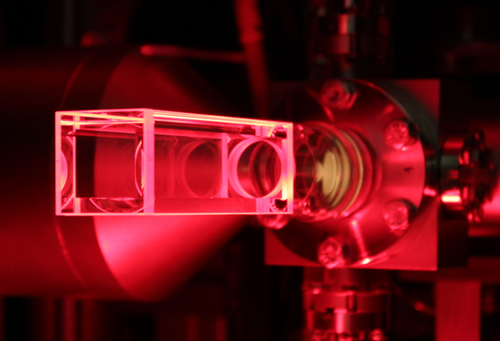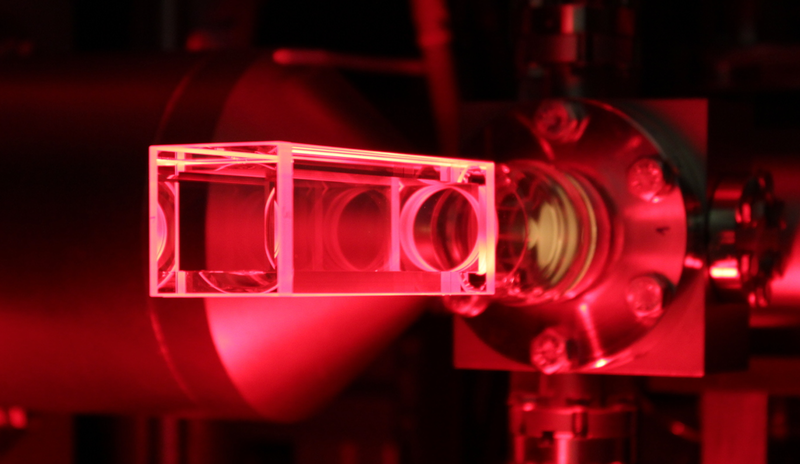Atoms As Thermometers
Temperature measurement is crucial for many atomic physics experiments, but usually it’s measured for an entire cloud of atoms. Now researchers have taken the first steps toward micrometer-scale temperature measurements within an ultracold cloud. The team released a handful of “thermometer” cesium atoms into a cloud of rubidium and then measured the atoms’ temperature to learn the rubidium cloud's temperature. The team also used an array of closely spaced traps to observe the individual cesium atoms’ locations, a trick that could lead to spatially resolved temperature measurements.
Researchers studying Bose-Einstein condensates (BECs)—ultracold gases in their quantum ground states—have learned a lot about the rules of quantum mechanics for a large number of interacting particles in equilibrium. However, their understanding of nonequilibrium quantum behavior, such as the formation of vortices in a BEC, is still incomplete. These experiments depend on precise temperature measurements, but currently researchers can only accurately measure the whole gas at once. To learn about the finer details of the phenomena, they need to resolve thermal variations to within a micrometer, says Artur Widera of the University of Kaiserslautern in Germany.
The tricky part is finding a thermometer that the experimentalist can control precisely and locate with micrometer accuracy. Widera and his colleagues had previously studied the interaction of individual cesium atoms with ultracold rubidium gas, so they chose cesium as their thermometer for rubidium. “We can identify, control, and detect [cesium atoms] independent of the gas,” Widera says. The rubidium temperature can be measured by standard methods, as a check on the new technique.
The team started with about 6 cesium atoms in a trap at the edge of a second, larger trap containing 10,000 rubidium atoms near its center. The rubidium temperature was between 0.1 and 5 microkelvin. The team chose to use few cesium atoms to avoid changing the rubidium gas’s temperature when the two were mixed. Next, the researchers released the cesium, allowing it to be drawn toward the rubidium cloud. Some cesium atoms collided with the rubidium atoms, exchanging kinetic energy in a process called thermalization, while others flew right through the cloud. The team then briefly turned off the trap for up to 3 milliseconds. The number of atoms that escape during such a release-recapture procedure depends on the temperature. So the researchers counted the remaining cesium atoms—by detecting fluorescence in response to a laser pulse—and then compared their data with computer simulations to learn the temperature.
However, to get an accurate temperature measurement, the researchers also needed to know the fraction of cesium atoms that had flown through the rubidium cloud without thermalizing with it. They used an array of traps (an optical lattice) spaced every 395 nanometers horizontally along the path between the two main traps to track the cesium atoms’ motion. The team ran the experiment many times, each time turning on the lattice at a different moment, freezing the atoms’ motion, and then imaging their positions with laser-induced fluorescence. They hope to use the optical lattice in the future to measure temperature with high spatial resolution.
Widera says that the team’s temperature measurement agreed with other experimental methods, which confirms that the cesium atoms work as thermometers and that the researchers can monitor their positions on the micrometer scale. He envisions future experiments where a rubidium BEC is prodded out of equilibrium, and cesium atoms would determine its temperature in a specific region with micrometer-scale resolution.
One limitation of the technique, says Jörg Schmiedmayer of the Vienna University of Technology, is that the experiment must be repeated many times to make a single temperature measurement, because so few cesium atoms are involved. Such repetition is common practice, but Schmiedmayer points out that it sacrifices potentially important details that are embedded in individual snapshots. However, he says that having many tools for studying these complicated nonequilibrium systems is necessary, and tinkering with a different technique could lead to important discoveries. “You might be able to learn about the local properties of a system in a different way,” Schmiedmayer says.
This research is published in Physical Review A.
–Sophia Chen
Sophia Chen is a freelance science writer based in Columbus, Ohio.





